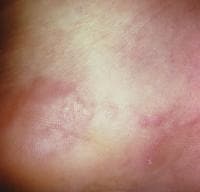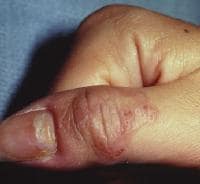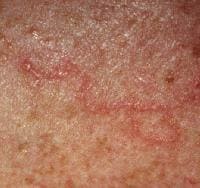Pathophysiology
In cutaneous larva migrans (CLM), the life cycle of the parasites begins when eggs are passed from animal feces into warm, moist, sandy soil, where the larvae hatch. They initially feed on soil bacteria and molt twice before the infective third stage. By using their proteases, larvae penetrate through follicles, fissures, or intact skin of the new host. After penetrating the stratum corneum, the larvae shed their natural cuticle. Usually, they begin migration within a few days.
In their natural animal hosts, the larvae of cutaneous larva migrans are able to penetrate into the dermis and are transported via the lymphatic and venous systems to the lungs. They break through into the alveoli and migrate to the trachea, where they are swallowed. In the intestine they mature sexually, and the cycle begins again as their eggs are excreted.
Humans are accidental hosts, and the larvae are believed to lack the collagenase enzymes required to penetrate the basement membrane to invade the dermis. Therefore, cutaneous larva migrans remains limited to the skin when humans are infected.
In their natural animal hosts, the larvae of cutaneous larva migrans are able to penetrate into the dermis and are transported via the lymphatic and venous systems to the lungs. They break through into the alveoli and migrate to the trachea, where they are swallowed. In the intestine they mature sexually, and the cycle begins again as their eggs are excreted.
Humans are accidental hosts, and the larvae are believed to lack the collagenase enzymes required to penetrate the basement membrane to invade the dermis. Therefore, cutaneous larva migrans remains limited to the skin when humans are infected.
Frequency
United States
Cutaneous larva migrans is rated second to pinworm among helminth infections in developed countries.
Mortality/Morbidity
Cutaneous larva migrans is benign and self-limited but can cause a disturbing pruritus.
Race
No specific racial predilection exists because cutaneous larva migrans depends on exposure.
Sex
Cutaneous larva migrans demonstrates no specific sexual predilection because cutaneous larva migrans depends on exposure.
Age
Cutaneous larva migrans can affect persons of all ages because it depends on exposure, but it tends to be seen in children more commonly than in adults.
Clinical
History
- Tingling/prickling at the site of exposure within 30 minutes of penetration of larvae, although Archer describes a case of late-onset cutaneous larva migrans (CLM
- Intense pruritus
- Erythematous, often linear lesions that advance
- Often associated with a history of sunbathing, walking barefoot on the beach, or similar activity in a tropical location
- Predispositions to contracting cutaneous larva migrans include the following:
- Hobbies and occupations that involve contact with warm, moist, sandy soil
- Tropical/subtropical climate travel
- Barefoot beachgoers/sunbathers
- Children in sandboxes
- Carpenter
- Electrician
- Plumber
- Farmer
- Gardener
- Pest exterminator
Physical
- Cutaneous signs of cutaneous larva migrans (CLM) include the following:
- Pruritic, erythematous, edematous papules and/or vesicles
- Serpiginous (snakelike), slightly elevated, erythematous tunnels that are 2- to 3-mm wide and track 3-4 cm from the penetration site
- Nonspecific dermatitis
- Vesicles with serous fluid
- Secondary impetiginization
- Tract advancement of 1-2 cm/d
- Systemic signs include peripheral eosinophilia (Loeffler syndrome), migratory pulmonary infiltrates, and increased immunoglobulin E (IgE) levels, but are rarely seen.
- Lesions are typically distributed on the distal lower extremities, including the dorsa of the feet and the interdigital spaces of the toes, but can also occur in the anogenital region, the buttocks, the hands, and the knees.
Patients who were sunbathing nude on a beach in Martinique presented with classic, erythematous, serpiginous tracts on the left heel.
Causes
- Common etiologies and where the parasites of cutaneous larva migrans (CLM) are most commonly found include the following:
- Ancylostoma braziliense (hookworm of wild and domestic dogs and cats) is the most common cause. It can be found in the central and southern United States, Central America, South America, and the Caribbean.
- Ancylostoma caninum (dog hookworm) is found in Australia.
- Uncinaria stenocephala (dog hookworm) is found in Europe.
- Bunostomum phlebotomum (cattle hookworm)
- Rare etiologies include the following:
- Ancylostoma ceylonicum
- Ancylostoma tubaeforme (cat hookworm)
- Necator americanus (human hookworm)
- Strongyloides papillosus (parasite of sheep, goats, and cattle)
- Strongyloides westeri (parasite of horses)
- Ancylostoma duodenale
- Pelodera (Rhabditis) strongyloides
References
- Edelglass JW, Douglass MC, Stiefler R, Tessler M. Cutaneous larva migrans in northern climates. A souvenir of your dream vacation. J Am Acad Dermatol. Sep 1982;7(3):353-8. [Medline].
- Herbener D, Borak J. Cutaneous larva migrans in northern climates. Am J Emerg Med. Sep 1988;6(5):462-4. [Medline].
- Jones WB 2nd. Cutaneous larva migrans. South Med J. Nov 1993;86(11):1311-3. [Medline].
- Patel S, Sethi A. Imported tropical diseases. Dermatol Ther. Nov-Dec 2009;22(6):538-49. [Medline].
- Tamminga N, Bierman WF, de Vries PJ. Cutaneous larva migrans acquired in Brittany, France. Emerg Infect Dis. Nov 2009;15(11):1856-8. [Medline].
- Archer M. Late presentation of cutaneous larva migrans: a case report. Cases J. Aug 12 2009;2:7553. [Medline].
- Jones CC, Rosen T, Greenberg C. Cutaneous larva migrans due to Pelodera strongyloides. Cutis. Aug 1991;48(2):123-6. [Medline].
- Jelinek T, Maiwald H, Nothdurft HD, Löscher T. Cutaneous larva migrans in travelers: synopsis of histories, symptoms, and treatment of 98 patients. Clin Infect Dis. Dec 1994;19(6):1062-6. [Medline].
- Rodilla F, Colomina J, Magraner J. Current treatment recommendations for cutaneous larva migrans. Ann Pharmacother. May 1994;28(5):672-3. [Medline].
- Van den Enden E, Stevens A, Van Gompel A. Treatment of cutaneous larva migrans. N Engl J Med. Oct 22 1998;339(17):1246-7. [Medline].
- Richey TK, Gentry RH, Fitzpatrick JE, Morgan AM. Persiste
PENGOBATAN
Yang perlu disimak dalam pengobatan :
Pengobatan.
Sebelum tahun 1960-an, pengobatan cutaneous larva migrans menggunakanChlorethyl, obat anastesi semprot dingin (biasa juga dipakai di persepakbolaan).
Sebelum tahun 1960-an, pengobatan cutaneous larva migrans menggunakanChlorethyl, obat anastesi semprot dingin (biasa juga dipakai di persepakbolaan).
Prior to the 1960s, topical modalities such as ethyl chloride spray, liquid nitrogen, phenol, carbon dioxide snow, piperazine citrate, electrocautery, and radiation therapy were used unsuccessfully because the larvae might be missed and/or not be killed. Lydia A Juzych, MD, April 10, 2006)
Ternyata obat semprot tersebut hanya menghambat, tidak membunuh cacing.
Perlu diketahui, larva cacing terhambat pada suhu di bawah 10 derajat cecius, tetapi tidak mati, dan baru bisa mati pada suhu minus 15 derajat celcius. Itulah mengapa disemprot Chlorethyl tak kunjung sembuh.
Yah, pindah berobat dong.
Perlu diketahui, larva cacing terhambat pada suhu di bawah 10 derajat cecius, tetapi tidak mati, dan baru bisa mati pada suhu minus 15 derajat celcius. Itulah mengapa disemprot Chlorethyl tak kunjung sembuh.
Yah, pindah berobat dong.
Obat yang dianjurkan antara lain:
Obat cacing: Obat pilihan adalah: thiabendazole, ivermectin dan albendazole, sedangkan obat lainnya Mebendazole.
Obat cacing: Obat pilihan adalah: thiabendazole, ivermectin dan albendazole, sedangkan obat lainnya Mebendazole.
Thiabendazole (apa sudah ada di Indonesia ?)
Dosis: 25-50 mg/kg berat badan/hari, diberikan 2 kali sehari selama 2-5 hari. Tidak diperkenankan melebihi 3 gram perhari.
Dapat juga diberikan secara topikal (obat luar) 10-15% dalam larutan.
Dosis: 25-50 mg/kg berat badan/hari, diberikan 2 kali sehari selama 2-5 hari. Tidak diperkenankan melebihi 3 gram perhari.
Dapat juga diberikan secara topikal (obat luar) 10-15% dalam larutan.
Albendazole. ( pilih yang ini )
Dosis dewasa dan anak di atas 2 tahun: 400 mg perhari, dosis tunggal, selama 3 hari atau 200 mg dua kali sehari selama 5 hari.
Dosis anak kurang dari 2 tahun: 200 mg perhari selama 3 hari.
Atau 10-15 mg per kg berat badan, 4 kali perhari selama 3-5 hari. Jining Wang, MD, February 28, 2006
Dosis dewasa dan anak di atas 2 tahun: 400 mg perhari, dosis tunggal, selama 3 hari atau 200 mg dua kali sehari selama 5 hari.
Dosis anak kurang dari 2 tahun: 200 mg perhari selama 3 hari.
Atau 10-15 mg per kg berat badan, 4 kali perhari selama 3-5 hari. Jining Wang, MD, February 28, 2006
Mebendazole
Dosis dewasa dan anak di atas 2 tahun: 100-200 mg dua kali sehari, selama 4 hari .
Anak kurang dari 2 tahun: tidak dianjurkan
Dosis dewasa dan anak di atas 2 tahun: 100-200 mg dua kali sehari, selama 4 hari .
Anak kurang dari 2 tahun: tidak dianjurkan
Anti alergi, untuk mengurangi alergi lokal, misalnya menggunakan hidrokortison cream atau sejenisnya.
Antibiotika, diberikan bila ada infeksi sekunder (bernanah)



Tidak ada komentar:
Posting Komentar